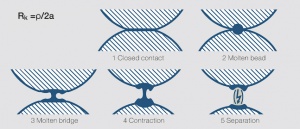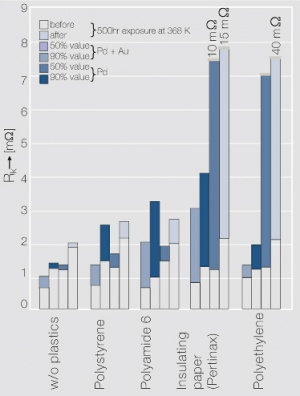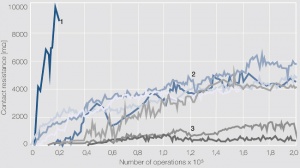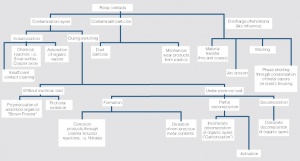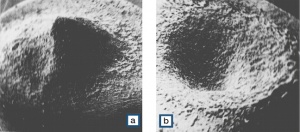Difference between revisions of "Schaltende Kontakte"
Doduco Admin (talk | contribs) (→Schaltende Kontakte) |
Teitscheid (talk | contribs) |
||
| (12 intermediate revisions by 2 users not shown) | |||
| Line 3: | Line 3: | ||
<li>'''Effekte bei Schaltvorgängen'''</li> | <li>'''Effekte bei Schaltvorgängen'''</li> | ||
| + | <xr id="fig:Contact_opening_with_arc_formation_schematic"/><!--Fig. 6.7:--> Kontaktöffnung unter Lichtbogenbildung (schematisch) | ||
<div class="multiple-images"> | <div class="multiple-images"> | ||
<figure id="fig:Contact_opening_with_arc_formation_schematic"> | <figure id="fig:Contact_opening_with_arc_formation_schematic"> | ||
[[File:Contact opening with arc formation schematic.jpg|left|thumb|<caption>Kontaktöffnung unter Lichtbogenbildung (schematisch)</caption>]] | [[File:Contact opening with arc formation schematic.jpg|left|thumb|<caption>Kontaktöffnung unter Lichtbogenbildung (schematisch)</caption>]] | ||
| − | |||
| − | |||
| − | |||
</figure> | </figure> | ||
</div> | </div> | ||
<div class="clear"></div> | <div class="clear"></div> | ||
| + | <li>'''Einfluss von Kunststoffausgasungen'''</li> | ||
| + | |||
| + | <xr id="fig:Histogram_of_the_contact_resistance_Rk"/><!--Fig. 6.9:--> Histogramm des Kontaktwiderstandes R<sub>K</sub> einer galvanischen Palladiumschicht (3 μm) mit und ohne Hartgoldflash (0,2 μm) | ||
| + | bei Auslagerung mit verschiedenen Kunststoffen | ||
| − | < | + | <xr id="fig:Contact resistance with exposure to out gasing from plastics"/><!--Fig. 6.10:--> Kontaktwiderstand und Ausgasungen aus Kunststoffen in Abhängigkeit von der |
| + | Schaltspielzahl bei 6 V<sub>DC</sub> , 100 mA: 1 silikonhaltiger Kunststoff; 2 Kunststoffe mit stark ausgasenden Komponenten; 3 Kunststoffe mit minimaler Ausgasung | ||
| Line 34: | Line 37: | ||
<li>'''Einfluss von Schadgasen auf den Kontaktwiderstand'''</li> | <li>'''Einfluss von Schadgasen auf den Kontaktwiderstand'''</li> | ||
| + | <xr id="fig:Distribution of cumulative frequency H of the contact resistance for solid contact rivets"/><!--Fig. 6.11:--> Distribution of cumulative frequency H of the contact resistance for solid contact rivets after 10 days exposure in a three-component test environment with 400 ppb each of H<sub>2</sub>S, SO<sub>2</sub> and NO<sub>2</sub> at 25°C, 75% RH; Contact force 10cN; Measuring parameters: ≤ 40 mV<sub>DC</sub>,10 mA; Probing | ||
| + | contact: Gold rivet | ||
<div class="multiple-images"> | <div class="multiple-images"> | ||
<figure id="fig:Distribution of cumulative frequency H of the contact resistance for solid contact rivets"> | <figure id="fig:Distribution of cumulative frequency H of the contact resistance for solid contact rivets"> | ||
| − | [[File:Distribution of cumulative frequency H of the contact resistance for solid contact rivets.jpg|left|thumb|<caption> | + | [[File:Distribution of cumulative frequency H of the contact resistance for solid contact rivets.jpg|left|thumb|<caption>Distribution of cumulative frequency H of the contact resistance for solid contact rivets after 10 days exposure in a three-component test environment with 400 ppb each of H<sub>2</sub>S, SO<sub>2</sub> and NO<sub>2</sub> at 25°C, 75% RH; Contact force 10cN; Measuring parameters: ≤ 40 mV<sub>DC</sub>,10 mA; Probing |
| − | 400 ppb H<sub>2</sub>S, SO<sub>2</sub> | + | contact: Gold rivet</caption>]] |
| − | |||
</figure> | </figure> | ||
</div> | </div> | ||
| Line 45: | Line 49: | ||
| − | ''' | + | [[File:Influences on contact areas in relays.jpg|right|thumb|Influences on contact areas in relays]] |
| + | |||
| + | <li>'''Contact Phenomena under the influence of arcing Matertia'''</li> | ||
<ul> | <ul> | ||
| − | <li>''' | + | <li>'''Material transfer'''</li> |
| + | <xr id="fig:Material transfer under DC load"/><!--Fig. 6.12:--> Material transfer under DC load a) Cathode; b) Anode. <br /> Material: AgNi0.15; Switching parameters: 12V<sub>DC</sub>, 3 A, 2x10<sup>6</sup> operations | ||
| − | <div class="multiple-images"><figure id="fig:Material transfer under DC load">[[File:Material transfer under DC load.jpg|left|thumb|<caption> | + | <div class="multiple-images"><figure id="fig:Material transfer under DC load">[[File:Material transfer under DC load.jpg|left|thumb|<caption>Material transfer under DC load a) Cathode; b) Anode. <br /> Material: AgNi0.15; Switching parameters: 12V<sub>DC</sub>, 3 A, 2x10<sup>6</sup> perations</caption>]]</figure></div> |
<div class="clear"></div> | <div class="clear"></div> | ||
| − | <li>''' | + | <li>'''Arc erosion'''</li> |
| + | <xr id="fig:Arc erosion of a AgSnO2 contact pair after extreme arcing conditions"/><!--Fig. 6.13:--> Arc erosion of a Ag/SnO<sub>2</sub> contact pair after extreme arcing conditions a) Overall view; b) Partial detail view | ||
| − | <div class="multiple-images"><figure id="fig:Arc erosion of a AgSnO2 contact pair after extreme arcing conditions">[[File:Arc erosion of a AgSnO2 contact pair after extreme arcing conditions.jpg|left|thumb|<caption> | + | <div class="multiple-images"><figure id="fig:Arc erosion of a AgSnO2 contact pair after extreme arcing conditions">[[File:Arc erosion of a AgSnO2 contact pair after extreme arcing conditions.jpg|left|thumb|<caption>Arc erosion of a Ag/SnO<sub>2</sub> contact pair after extreme arcing conditions a) Overall view; b) Partial detail view</caption>]]</figure></div> |
<div class="clear"></div> | <div class="clear"></div> | ||
| + | <li>'''Contact welding'''</li> | ||
| − | < | + | <xr id="fig:Micro structure of a welded contact pair after extremely high current load"/><!--Fig. 6.14:--> Micro structure of a welded contact pair (Ag/SnO<sub>2</sub>88/12 - Ag/CdO88/12) after extremely high current load. a) Ag/SnO<sub>2</sub>88/12; b) Ag/CdO88/12 |
| − | |||
<div class="multiple-images"> | <div class="multiple-images"> | ||
<figure id="fig:Micro structure of a welded contact pair after extremely high current load"> | <figure id="fig:Micro structure of a welded contact pair after extremely high current load"> | ||
| − | [[File:Micro structure of a welded contact pair after extremely high current load.jpg|left|thumb|<caption> | + | [[File:Micro structure of a welded contact pair after extremely high current load.jpg|left|thumb|<caption>Micro structure of a welded contact pair (Ag/SnO<sub>2</sub>88/12 - Ag/CdO88/12) after extremely high current load. a) Ag/SnO<sub>2</sub>88/12; b) Ag/CdO88/12</caption>]] |
| − | |||
</figure> | </figure> | ||
</div> | </div> | ||
| Line 73: | Line 80: | ||
</ul> | </ul> | ||
| − | == | + | ==References== |
| − | [[ | + | [[Application Tables and Guideline Data for Use of Electrical Contact Design#References|References]] |
[[en:Switching_Contacts]] | [[en:Switching_Contacts]] | ||
Revision as of 15:31, 17 September 2014
Schaltende Kontakte
- Effekte bei Schaltvorgängen
- Einfluss von Kunststoffausgasungen
- Einfluss von Schadgasen auf den Kontaktwiderstand
- Contact Phenomena under the influence of arcing Matertia
- Material transfer
- Arc erosion
- Contact welding
Figure 1 Kontaktöffnung unter Lichtbogenbildung (schematisch)
Figure 2 Histogramm des Kontaktwiderstandes RK einer galvanischen Palladiumschicht (3 μm) mit und ohne Hartgoldflash (0,2 μm) bei Auslagerung mit verschiedenen Kunststoffen
Figure 3 Kontaktwiderstand und Ausgasungen aus Kunststoffen in Abhängigkeit von der Schaltspielzahl bei 6 VDC , 100 mA: 1 silikonhaltiger Kunststoff; 2 Kunststoffe mit stark ausgasenden Komponenten; 3 Kunststoffe mit minimaler Ausgasung
Figure 4 Distribution of cumulative frequency H of the contact resistance for solid contact rivets after 10 days exposure in a three-component test environment with 400 ppb each of H2S, SO2 and NO2 at 25°C, 75% RH; Contact force 10cN; Measuring parameters: ≤ 40 mVDC,10 mA; Probing contact: Gold rivet
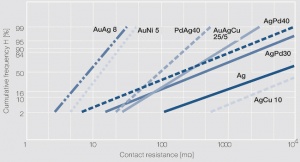
Figure 5 Material transfer under DC load a) Cathode; b) Anode.
Material: AgNi0.15; Switching parameters: 12VDC, 3 A, 2x106 operations
Figure 6 Arc erosion of a Ag/SnO2 contact pair after extreme arcing conditions a) Overall view; b) Partial detail view
Figure 7 Micro structure of a welded contact pair (Ag/SnO288/12 - Ag/CdO88/12) after extremely high current load. a) Ag/SnO288/12; b) Ag/CdO88/12
